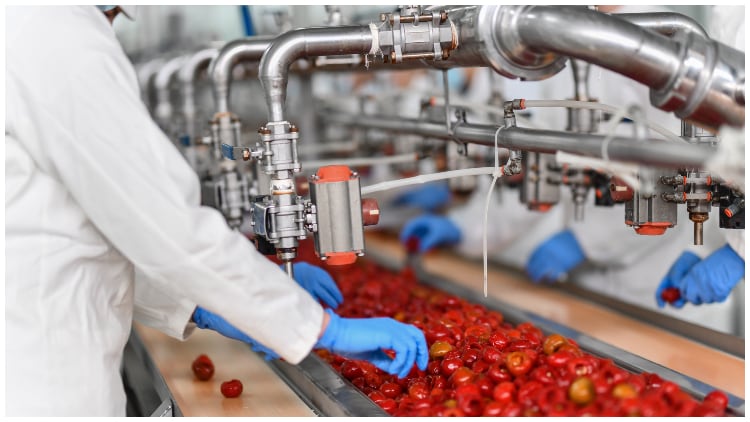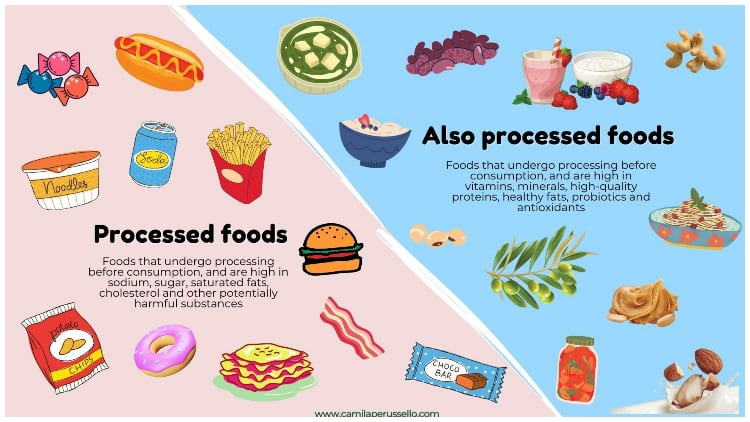Food processing often receives a bad press. This is largely due to modern communication systems where everyone can express opinions, many of which are inaccurate and untrue. This leaves consumers concerned and often confused. It is time, therefore, that the wider food science/food processing communities mounted a defence.
Many of these aspects were raised in a recent review paper entitled, ‘It is time to appreciate the value of processed foods’.1 Additionally ‘food processing is here to stay’ were wise words spoken at a roundtable session at the recent EFFoST (European Federation of Food Science & Technology) conference in Dublin last November.
Some of the discussion at the event centred on the importance of bringing consumers on-side by informing/reassuring them about existing, as well as new and emerging processing technologies.
Here the key outcomes from the EFFoST session are summarised, together with other related issues including ultra-processed foods.
Healthy and sustainable diets – the European Technology Platform ‘Food for Life’
In his presentation, Gert Meijer, deputy head of corporate regulatory and scientific affairs at Nestlé discussed the role of food processing in achieving healthy and sustainable diets in the context of the joint viewpoint between the EFFoST and the European Technology Platform (ETP) Food for Life (FFL).
The ETP-FFL is an industry-led stakeholder forum which includes academic experts with the aim of stimulating innovation in the European food industry to the benefit of a sustainable society. Four global key challenges have been identified: consumer engagement, demographic changes, food security and sector maturity.
The ETP-FFL response/answer embraces the following points:
- To develop a sound research and innovation (R&I) strategy
- Implement the strategy
- Mobilise all relevant actors
- Monitor and guide the implementation.
Since 2005 the ETP-FFL has produced several R&I strategies in food including, achieving more sustainable food systems through R&I and the FFL implementation action plan. The underpinning element of the R&I strategies is the role of food processing in achieving healthy and sustainable diets as outlined in the EU Farm to Fork Strategy (2020).
Food processing is essential in this transition and the food sector ‘to do’ list includes factors such as reducing environmental impacts and using food innovation to lessen the load on the environment. It also encourages continued research into the relationship between food processing and assessing the potential impacts on health and the environment; as well as more transparency on food formulation and food processing to restore consumer trust. Finally, it encourages the embracement of new technologies to help deliver sustainably produced food to a growing population.
Moderating energy intake from processed foods
Another point which was raised at the conference was shared by Ciarán Forde, a professor in sensory science and eating behaviour at Wageningen University and Research, who outlined the role of sensory cues in moderating energy intake from processed foods and especially from ultra-processed foods.
The most important factor when considering nutrition and public health is not nutrients or foods, but what is done to the food as a result of processing. A randomised controlled inpatient trial on energy intake from unprocessed vs. ultra-processed diets was cited, in which the latter caused excess calorie intake and weight gain.2 It was concluded that limiting consumption of ultra-processed foods may be an effective strategy for obesity prevention and treatment.
Factors driving sustained higher energy intakes from such foods include emulsifiers/additives, hyper-palatability, taste-nutrient disruptions, food matrix/microbiome interactions, reward value/food enforcement, softer texture and higher energy density.

A recent study3 showed that ad-libitum meal intake is driven by texture not processing i.e., circa 33% more was consumed when the meal was soft textured compared with hard textured for both unprocessed and ultra-processed. Reformulating the food supply offers many opportunities to improve health and it is forecast that a large proportion of food products on shelves today will be gone within five years due to continued innovation and product reformulation.4
It was also stressed that food processing has an image problem around negative consumer perception. Despite this, it’s expected that consumption of processed foods will rise as the push for more food security, sustainability and reformulation increases apace.
Healthy and sustainable processed diets
Meanwhile Eileen Gibney, professor of nutrition at the University College Dublin, flagged the challenges in finding the balance between healthy and sustainable processed diets.
The importance of linking nutrients, foods and diets was stressed with examples including, dietary fats and coronary heart disease, red and processed meat and colorectal cancer incidence, and adherence to Mediterranean diet and health status.5-7
The FAO/WHO recommendations for the development of food-based dietary guidelines were also outlined in a public health context: to identify target and related nutrients, to identify foods rich in target nutrients and select options for dietary strategies, and to identify foods and food groups for inclusion in food based dietary guidelines. Areas feeding into this sequence comprise food availability, price, cultural acceptability, displaced foods and their impact on nutrient supply, and dietary patterns of consumers high and low in the target nutrient.8
Key learnings from the presentation featured:
- A lack of definition and data on food processing is a major gap
- Foods/diets cannot be examined in isolation (all parameters must be considered)
- That research is needed to align food item and food group datasets
- We must link actual food consumption data to health parameters.
Food processing as an enabler
In her address, Lilia Ahrné of the University of Copenhagen discussed food processing as a key enabler for securing the food system from farm to fork today and tomorrow.
She explained that food processing complements the four main pillars of the farm to fork concept:
- Sustainable food production that embraces food safety and quality
- Sustainable food processing and distribution that includes economic aspects, such as value addition and the requirements of urbanisation
- Sustainable food consumption which requires availability and affordability
- Food loss and waste prevention with the ultimate target of Net Zero.
Processing for food safety and stability includes controlling water (drying, frying and freezing), thermal and non-thermal pasteurisation and sterilisation, modified atmosphere packaging, and fermentation.
Ahrné also highlighted the opportunities for food processing to move towards Net Zero, examples of which she listed as switching from hydrocarbon to renewable energy sources, using alternative varieties and crops, nutrient retention and enhancement through processing, among others.
Consumer perspectives on processed foods
Liisa Lähteenmäki, who specialises in consumer behaviour within the food domain at Aarhus University, emphasised that consumers often see the negative aspects of food processing. However, processed food has changed consumers’ world, providing nutritious, tasty food to growing populations. Questions are being raised on the ‘healthfulness’ of processed foods, with more and more studies searching for an answer.
Classification systems for foods such as NOVA are ambiguous, inconsistent and often give insufficient weight to scientific evidence on nutrition and food processing methods. Processing is linked to food safety in consumers’ minds and most respondents in a Eurobarometer study9 mentioned processing and food production as moderate concerns.
At household level, consumers can decide on food choice/preparation and there is a perception of having control over risks – not so with processed foods. Processing is a hidden product attribute that cannot be directly experienced and is more noticed in relation to concerns than to benefits. Going forward consumers need to trust the information they receive from manufacturers and perhaps food packages should inform how the product is processed.
Consumers weigh up the pros and cons of what processing methods bring to them, i.e., who is benefiting from the adopted methods, are there health risks, and what benefits and health-related (both human and planetary) risks are there in new processing methods.
‘Natural’ in food signifies something positive and ‘pure’ to consumers as opposed to terminology such as ‘manmade’, i.e., consumers are sensitive to how food is produced and ingesting anything ‘bad’ may contaminate them. For example, ultra-processed foods may be viewed as convenient, hyper-palatable and highly profitable products for the food industry, but they are liable to displace freshly prepared home-cooked meals.
Finally, benefits and risks of/from processing should be dissected from what is processed, and openness about new processing technologies is key to building trust.
Concluding thoughts and next steps for the food sector
Most consumers in developed countries are familiar with and accept (to a large degree) mainstream food processes such as canning, dehydration, chilling, freezing, fermentation and pasteurisation. However, newer methods such as non-thermal processes leave them confused about what such processes entail.
All five presentations extolled the virtues of food processing and the need to make consumers more aware of what is involved. However, no new ideas were generated on effective methods for connecting with consumers. Difficulties in connecting effectively with consumers were highlighted in the FLAIR-FLOW Europe (F-FE) Dissemination Project, where dissemination of food research results to SMEs and health professionals was highly successful but not to consumer groups/consumers who were reluctant to interact.10
The F-FE project preceded modern social media communication systems, yet these systems are open to abuse and often provide fake and scare information. A possible, successful route to consumers could be public-good, online lectures from a university or a food research institute on the pros and cons of food processing. The lecture series could be flagged extensively on national radio in small countries or on a regional basis in large countries to alert consumers. Alternatively, a TV or radio channel could host such a lecture series.
References
- Fitzgerald, M. 2023. ‘It is time to appreciate the value of processed foods’. Trends in Food Science & Technology, 134, 222-229.
- Hall, K. & 26 co-authors. 2019. Ultra-processed diets cause excess calorie intake and weight gain: An inpatient randomized controlled trial of ad libitum food intake. Clinical Translational Report. Cell Metabolism, 30(1), 67-77.
- Teo, P.S. & 6 co-authors. 2022. Texture-based differences in eating rate influence energy intake for minimally processed & ultra-processed meals. American Journal of Clinical Nutrition, 116(1), 244-254.
- FoodDinkEurope Annual Report. 2021. https://www.fooddrinkeurope.eu/resource/fooddrinkeurope-annual-report-2021/
- Willet, W.C. 2012. Dietary fats & coronary heart disease. Journal of Internal Medicine, 272(1), 13-24.
- Chan, D.S.M. & 6 co-authors. 2011. Red and processed meat & colorectal cancer incidence: meta-analysis of prospective studies. PubMed. On –line at: https://doi.org/10.1371/journal.pone.0020456
- Sofi, F. & 3 co-authors. 2008. Adherence to Mediterranean diet & health status: meta-analysis. British Medical Journal. On-line at: https://www.bmj.com/content/bmj/337/bmj.a1344.full.pdf
- Gibney, M.J. & 3 co-authors. 2017. Ultra-processed foods in human health: a critical appraisal. American Journal of Clinical Nutrition, 106(3), 717-724.
- Eurobarometer, 2010. Survey report on risk perception in the EU https://www.efsa.europa.eu/en/corporate/pub/eurobarometer10
- Gormley, R. 2000. Dissemination Blueprint: The FLAIR-FLOW Experience, F-FE 382/00, 6-pages.




